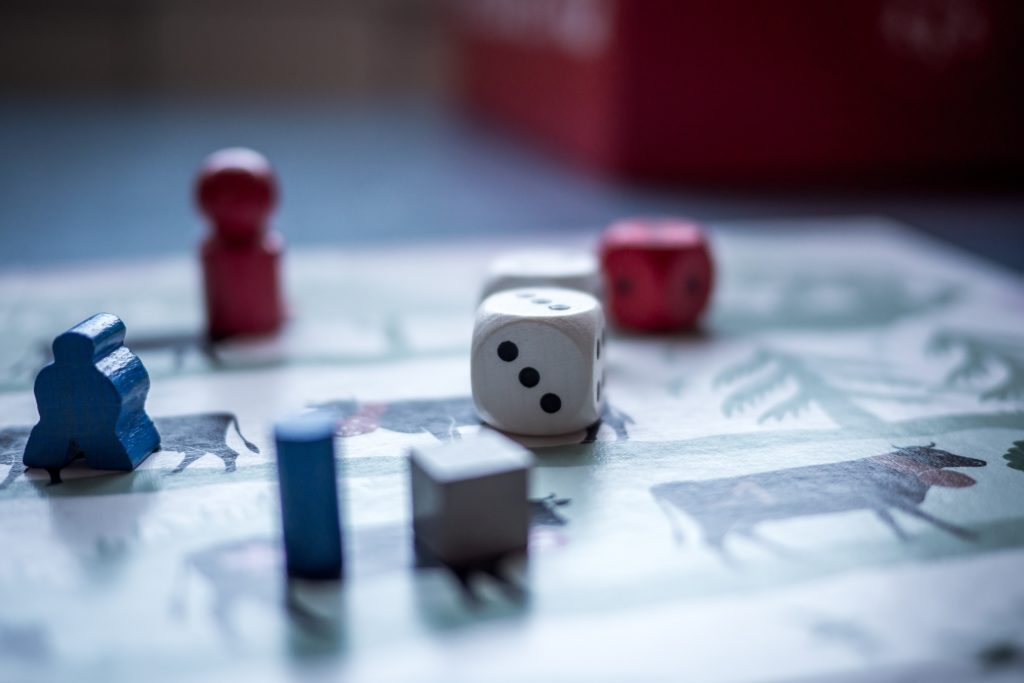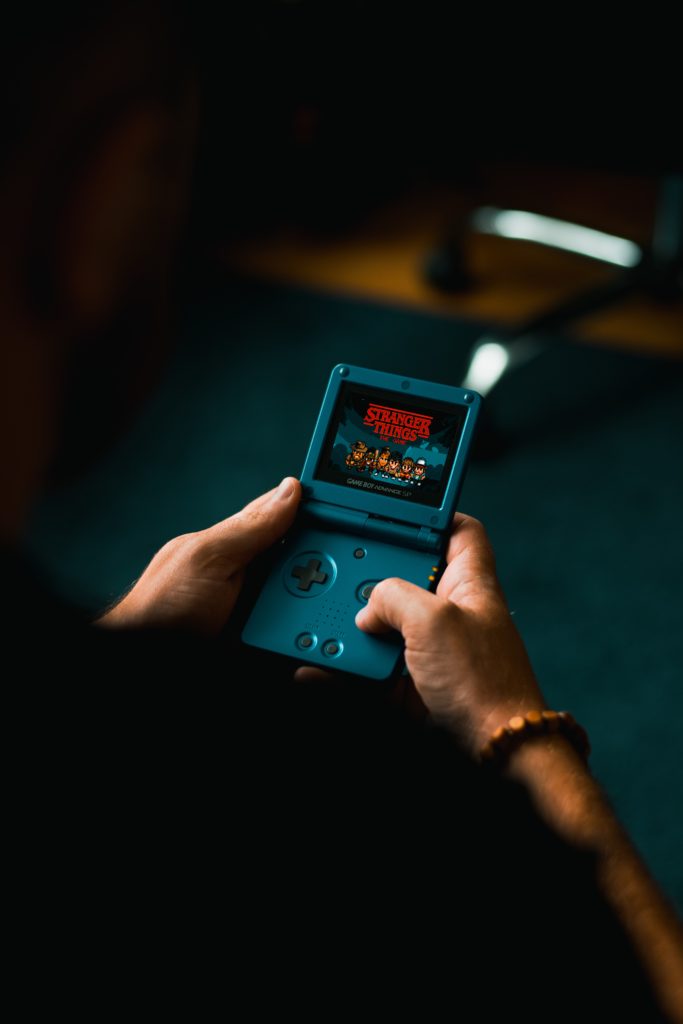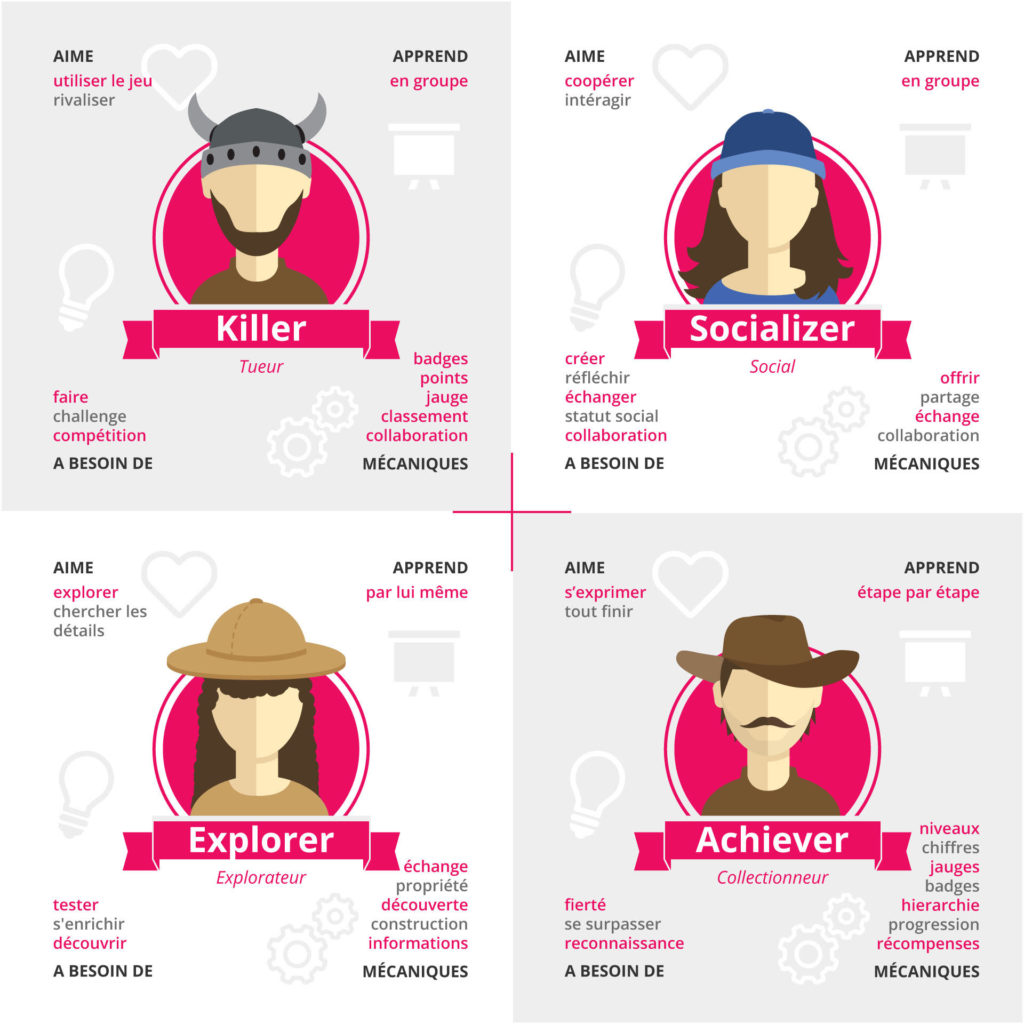Rédigé avec la participation de Alexandre Chenette, enseignant et conseiller pédagogique au Service national du RÉCIT, domaine du développement de la personne.
Un dossier conjoint de Carrefour éducation et L’École branchée
Jeu et apprentissage sont intimement liés, et ce depuis toujours. Peu importe la forme qu’ils prennent, les jeux, du simple jeu de cartes jusqu’au jeu vidéo le plus sophistiqué, représentent une excellente façon d’intérioriser la motivation, de stimuler l’engagement, la persévérance et le dépassement de soi. Ils sont porteurs de sens, développent l’autonomie, le sentiment de compétence, favorisent la créativité mais aussi la collaboration. Ils permettent même d’apprendre, de développer de nouvelles compétences, d’acquérir des connaissances, sans même s’en rendre compte (ou presque!).
Pas étonnant que de nombreux pédagogues tendent à intégrer le jeu dans leur salle de classe (même si celle-ci est en mode virtuel). Depuis une dizaine d’années, la gamification, aussi appelée ludification, a peu à peu gagné en popularité dans le monde scolaire. Il s’agissait à la base d’intégrer principalement des principes associés à l’univers du jeu vidéo dans l’enseignement (mécanisme de récompense, de quête, etc.). Bref, exit le traditionnel cours magistral!
De nombreux termes et plusieurs façons de faire ont été explorés, si bien que la ludification a pu sembler comme une expérience des plus complexes à mettre en place pour certains enseignants. Pour d’autres, elle aura semblé futile en raison du caractère « amusement » associé au jeu. D’ailleurs, pour s’éloigner de la « mauvaise réputation » qu’a pu avoir le terme ludification, le mot ludicisation est de plus en plus employé. Celui-ci fait davantage référence au fait de rendre l’apprentissage ludique plutôt qu’à celui d’intégrer des mécanismes de jeu à l’enseignement.
Dans ce dossier, nous vous proposons un tour d’horizon du monde de la ludification/ludicisation et nous vous expliquons pourquoi cette pratique est accessible à l’ensemble des enseignants. Car, nul besoin de revoir de fond en comble ses pratiques pédagogiques pour apporter une touche ludique à sa classe. Le secret est parfois dans les petits gestes qui font une différence.
Table des matières
- La ludification, c’est quoi au juste?
- Que dit la recherche? L’impact de la ludification sur les élèves.
- Par où commencer?
- Possible de ludifier à distance?
- Des outils à explorer
- Bon pour les profs aussi?
1- La ludification, c’est quoi au juste
Avant de plonger dans l’univers de la ludification, il apparaît nécessaire de faire un retour en arrière. Tout d’abord, il faut savoir que ce terme n’est pas exclusif au monde de l’éducation. Cartes de fidélité, systèmes de points et de remise, ça vous dit quelque chose? Ces façons de faire font le bonheur des responsables de marketing du monde entier.
Il s’agit en fait de l’utilisation de mécanismes traditionnellement associés au jeu vidéo dans des contextes autres que ceux du jeu (commerce, santé, réseaux sociaux, plateformes Web, etc.). La gamification (ludification) promet ainsi d’augmenter l’engagement et la rétention de la clientèle visée en les incitant à consommer davantage des produits et services, ce que plusieurs ont souvent associé à la motivation extrinsèque. Bref, celle-ci n’avait rien à voir avec le plaisir généralement associé au monde du jeu, mais davantage avec le désir de modifier des comportements, de poser des gestes précis pour obtenir des récompenses.
Appliquée à l’éducation, « la ludification se veut l’intégration à l’enseignement de différentes postures (règles, rôles, actions, etc.) et d’artéfacts (système de points, objets servant au jeu, jeux vidéo, etc.) visant à ajouter une touche ludique à une situation qui ne l’est pas forcément au départ », explique Mikaël Roberge, de l’Université de Sherbrooke, dans un précédent dossier publié conjointement par l’École branchée et Carrefour éducation.

Précisons que la ludification, bien que souvent associée au jeu vidéo, n’a pas à être technologique ou numérique pour être considérée comme telle. Il suffit de penser à l’utilisation de dés ou de jeux de cartes. Elle tend néanmoins à l’être de plus en plus dans le contexte actuel.
Comme mentionné en introduction, la ludification a pu parfois avoir mauvaise presse dans le monde de l’éducation en raison du caractère futile souvent associé à l’univers du jeu. « Ce n’est pas parce qu’on associe le jeu à un passe-temps qu’il est une activité vide de sens, bien au contraire; les jeux en général sont des activités pouvant être très profitables dans un contexte d’enseignement », indique cependant M. Roberge dans le même dossier cité ci-haut.
Yu-Kai Chou, le père de la ludification
Face à la perception négative et à une certaine incompréhension de la ludification (pas seulement dans le monde de l’éducation, mais également dans les domaines du marketing et de l’entrepreneuriat), le spécialiste Yu-Kai Chou, figure phare de la gamification, invite désormais à s’éloigner des mécanismes de récompenses tape-à-l’oeil (game-centered design), associés à l’univers du jeu et à la motivation extrinsèque, pour se concentrer davantage sur l’humain en examinant plus en détail les véritables facteurs de motivation qui lui sont propres (human-centered design), et donc, à la motivation intrinsèque.
Yu-Kai Chou est un entrepreneur, designer, auteur et consultant taïwanais qui fut dès 2003 l’un des plus importants pionniers de l’industrie de ce que deviendra la gamification, bien avant que le terme soit connu du grand public. Il a contribué à sa définition et à sa popularité. Il définit également les huit principaux moteurs de la motivation humaine.
« Si on demande à un joueur pourquoi un jeu est amusant, il ne dira pas que c’est parce qu’il y a des points. Il dira que c’est parce qu’il y a du challenge, parce que ça lui fait utiliser sa créativité, parce que ça fait de lui plus que ce qu’il était hier ». Voilà la philosophie de Yu-Kai Chou.
D’ailleurs, la notion de plaisir est un aspect majeur dans toute expérience liée au jeu, contribuant à la motivation bien personnelle. Au final, on joue à notre jeu favori pour le jeu en soi et le plaisir qu’il nous procure, pas pour les points et les niveaux qu’on y gagne, ceux-ci n’étant qu’une partie infime et secondaire de l’expérience.
Alexandre Chenette, du Service national du RÉCIT, domaine du développement de la personne, s’est abondamment penché sur les travaux de Yu-Kai Chou et les a adaptés au monde de l’éducation en présentant les huit principaux moteurs de la motivation humaine.
- Sens épique et vocation
- Développement et accomplissement
- Autonomie créative et rétroaction
- Propriété et possession
- Influence sociale et connexion
- Rareté et impatience
- Imprévisibilité et curiosité
- Peur de la perte et évitement
Ceux-ci sont présentés plus en détail dans un article sur le site de l’École branchée: 8 leçons tirées des jeux vidéo pour augmenter la motivation et l’engagement.
Vers la ludicisation
Cette nouvelle façon d’aborder la ludification pourrait sourire au domaine de l’éducation, où les visées ne sont pas la croissance et le profit comme dans l’univers marketing, mais plutôt le développement et l’acquisition de connaissances et de compétences chez les jeunes.
En effet, l’importance de « l’humain » (la relation pédagogue-apprenant, l’effet enseignant, le sentiment d’efficacité personnelle, les aptitudes socioaffectives, etc.) est cruciale pour l’apprentissage des élèves.
Dans cette optique, une nouvelle terminologie tend à apparaître pour décrire le fait de rendre l’enseignement plus ludique. Le terme ludification, associé aux mécanismes de rétention et à la motivation extrinsèque, pourrait être remplacé par le terme ludicisation, qui ferait davantage référence au fait de stimuler les facteurs de motivation intrinsèque chez les élèves. Dans leur plus récent ouvrage, Margarida Romero et Eric Sanchez, Apprendre en jouant (2020), abordent cette notion. On parlerait donc désormais de ludiciser l’enseignement.

Gamification, ludification, jeux sérieux….
LUDIFICATION (v.f. de gamification) : Utilisation de mécanismes traditionnellement associés aux jeux vidéo dans des contextes autres que ceux du jeu (commerce, santé, réseaux sociaux, plateformes web, etc.).
LUDICISATION : Ludiciser l’apprentissage, c’est le rendre plus agréable, amusant et engageant en adoptant une attitude ludique. Plutôt que de se concentrer sur les mécanismes de récompenses du jeu (game-centered design), la ludicisation invite à explorer les facteurs de motivation humaine stimulés par le jeu (human-centered design).
JEUX SÉRIEUX (v.f. de serious games) : Comme leur nom l’indique clairement, il s’agit de jeux mais dont l’objectif principal est sérieux comme par exemple l’apprentissage (alloprof) ou la résolution de problèmes scientifiques (PHYLO, fold.it). Une précision de Mikaël Roberge : « Jeu sérieux […] ne devrait pas être synonyme de jeu éducatif, car tous les jeux ont un potentiel éducatif. […] [Et] ce n’est pas parce qu’on ajoute le terme « sérieux » à « jeu » que celui-ci permet l’apprentissage. Tout comme on peut apprendre en jouant à un jeu vidéo commercial, il est possible de ne rien apprendre en jouant à un jeu sérieux. »
En complément :
– Exploiter les jeux numériques pour favoriser l’apprentissage : mission possible!, 25 mai 2017, l’École branchée
– L’enseignement à distance dans les universités et les cégeps : le jeu pour faciliter l’apprentissage, 15 mai 2020, The Conversation
– Battre le boss, Ludiciser l’apprentissage, présentation de Alexandre Chenette, RÉCIT
2- Que dit la recherche? Les effets de la ludicisation sur les élèves
Maintenant que nous comprenons un peu mieux à quoi fait référence la ludicisation, tournons-nous vers les retombées positives qu’elle peut avoir dans une salle de classe.
Il est vrai que le jeu est souvent associé à une augmentation de la motivation et de l’engagement chez les élèves, mais qu’en est-il réellement?
D’abord, rappelons-nous que le jeu symbolique (faire semblant de…) est au coeur des apprentissages au préscolaire. Celui-ci permet notamment « d’enrichir son langage oral, de développer sa conscience phonologique et d’être initié au langage écrit ». Ensuite, la notion de jeu se perd peu à peu alors que les enfants passent d’un niveau scolaire à l’autre.
Pourtant, nombre d’études ont démontré le rôle positif du jeu dans l’apprentissage. Il est parfois difficile de mettre les études en lien les unes avec les autres en raison des définitions différentes et du vocabulaire qu’elles utilisent. Par contre, des constantes reviennent souvent.
Engagement dans la tâche et motivation à apprendre en font partie. Le jeu contribue aussi au développement de compétences spécifiques, comme la collaboration, la résolution de problèmes, l’autonomie, et favorise la créativité chez les jeunes.
De façon générale également, les recherches confirment que le jeu permet :
- d’interagir et de socialiser, que ce soit dans un objectif de collaboration ou de compétition (Lenhart, 2008);
- une stimulation sensorielle (images, musique, actions, etc.) ou émotionnelle (présence d’une trame narrative, personnages intéressants, etc.) (Tisseron, 2013).
« Les meilleurs jeux permettent de capter l’attention des joueurs pour de longues périodes, tout en procurant un sentiment d’accomplissement et de bien-être important », rappellent Alexandre Lillo et Thomas Burelli dans leurs travaux de recherche. Ce phénomène se nomme « l’état de flow », selon les travaux de Mihaly Csikszentmihalyi, un état de concentration maximale très propice à l’apprentissage.
Par ailleurs, la grande majorité des études sur le jeu et l’apprentissage se sont penchées sur l’impact des jeux vidéo en particulier, compte tenu de la grande place qu’ils occupent dans notre société et dans le quotidien des jeunes. Selon Jane McGonigal, chercheuse et game designer, la moyenne des gens aura consacré environ 10 000 heures aux jeux vidéo avant l’âge de 21 ans, ce qui équivaut approximativement au temps passé en classe de la cinquième année à la fin du secondaire.
Au Canada, selon l’étude Amateurs de jeux vidéo au Canada – Faits essentiels 2020, 90 % des adolescents de 13 à 17 ans (60 % des adolescentes) et 82 % des hommes de 18 à 34 ans (58 % des femmes) se considèrent comme des joueurs de jeux vidéo. Au Québec, toujours selon la même étude, on estime à 57 % le nombre d’adultes qui s’amusent aux jeux vidéo, à 37 l’âge moyen des joueurs et à 8 h par semaine le temps moyen passé à jouer.
Ainsi, les études en lien avec l’usage des jeux vidéo se multiplient afin de mieux comprendre le phénomène et de cerner les bienfaits de leur intégration en éducation. Par exemple, à Montréal, la Chaire de recherche du Canada sur le numérique en éducation a réalisé un projet de recherche en intégrant le jeu Minecraft de façon très structurée dans des classes de la 3e à la 6e année du primaire. « Les élèves ont fait preuve d’une motivation accrue à l’égard de l’école, de meilleures compétences en informatique, en lecture et en écriture, de meilleures aptitudes à la résolution de problèmes, d’une plus grande créativité et autonomie, et d’une collaboration accrue avec leurs camarades de classe. »

Seuls, mais en groupe
Autre élément à prendre en considération : les jeux de groupe représenteraient une excellente manière d’aider les élèves à développer leurs compétences individuelles. Une étude de l’American Institute of Research a conclu que l’apprentissage collectif répond aux besoins d’apprentissage personnels, puisque les joueurs qui éprouvent des difficultés sont soutenus par leurs pairs afin qu’ils puissent progresser dans le jeu.
On pourrait penser que l’apprentissage personnalisé (pour répondre aux besoins d’un élève en particulier) devrait être individualisé (lui offrir une situation d’apprentissage ludique spécialement conçue pour lui). Cependant, les chercheurs ont constaté que « les étudiants qui ont expérimenté davantage de collaboration ont connu une plus grande croissance de leur apprentissage personnel ». Ainsi, la force du groupe contribuerait à élever chaque joueur individuellement.
En complément:
– Hamlen, K. R. (2013). Understanding children’s choices and cognition in video game play: A synthesis of three studies. Zeitschrift für Psychologie, 221(2), 107-114.
– Lenhart, A., Kahne, J., Middaugh, E., Rankin M., A. Evans, C. et Vitak, J. (2008). Teens, video games and civics: Teens gaming experiences are diverse and include significant social interaction and civic engagement. En ligne : http://files.eric.ed.gov/fulltext/ED525058.pdf. Consulté le 15 janvier 2020.
– Tisseron, S. et Khayat, D. (2013), Étude préliminaire de validation d’un questionnaire évaluant le type d’interaction dans les jeux vidéo. Neuropsychiatrie de l’enfance et de l’adolescence, 61, p. 81–92
– Granic, I., Lobel, A. et Engels R.C. (2013). The benefits of playing video games. American Psychologist, 69(1), 66-78
– Tardif N. (1992). Dans L’interdisciplinarité : une voie d’avenir. Actes de colloque. Sherbrooke.
– « Minecraft peut aider à apprendre et à résoudre des problèmes – oui, oui à l’école! », 24 avril 2019, The Conversation
– « L’enseignement à distance dans les universités et les cégeps: le jeu pour faciliter l’apprentissage », 15 mai 2020, The Conversation
– « Working in a group might be the best way to help kids meet individual goals, study says », 24 septembre 2019, The Hechinger Report
– Amateurs de jeux vidéo au Canada – Faits essentiels 2020, Association canadienne du logiciel de divertissement, 2020
– « Sondage sur les jeux vidéo en pandémie: un véritable exutoire pour les jeunes et les moins jeunes », 17 novembre 2020, Le Journal de Montréal
– Hours spent on playing video games per week in Canada 2020, 19 novembre 2020, Alexander Kunst
Une pratique qui gagne en popularité
Sans parler nécessairement d’engouement, il y a définitivement un intérêt croissant pour la ludicisation de la part des enseignants. « Je dirais qu’il y a une plus grande curiosité depuis 2-3 ans. Les enseignants souhaitent en savoir plus sur les façons d’amener des éléments plus ludiques à leur enseignement. Ils sont conscients qu’il peut y avoir des avantages pour leurs élèves. Ils veulent varier leurs approches et la ludification en fait partie », indique Mathieu Beauséjour, enseignant en univers social au Collège St-Sacrement.
Depuis 4 ans, il est responsable de la rétroaction et de l’évaluation des productions des apprenants qui suivent la formation Ludification du CADRE21. Il est d’ailleurs le seul à avoir atteint le plus haut niveau (#4 Innovateur) de cette autoformation, qui elle aussi comporte des éléments de ludicisation, comme l’ensemble de l’offre du CADRE21. Nous y reviendrons dans la section suivante de ce dossier.
Samuel Bernard, enseignant de 6e année à l’école Saint-Albert-le-Grand à Québec, a complètement ludicisé sa classe depuis deux ans. Concrètement, cela signifie qu’il a ajouté une trame narrative à l’ensemble de sa planification de l’année. Les élèves créent leur personnage (avatar) à la rentrée, puis, ils accèdent à des parcours, complètent des quêtes, etc. Le vocabulaire a été adapté en conséquence; il n’y a pas d’examen, mais des batailles et les équipes sont des guildes, par exemple. Les activités ne sont pas nécessairement numériques, des planches de jeu physiques proposent aussi des défis particuliers aux élèves.
« Je propose un univers ludique à mes élèves, même si, au final, ils voient la même matière que les autres élèves de 6e année », dit-il. Il convient qu’il lui a fallu de nombreuses heures d’adaptation pour en arriver à ce résultat. Il s’est principalement inspiré des travaux de Scott Hebert, un enseignant albertain qui est devenu la référence dans le domaine. Car, dans le monde de la ludicisation de classe, il existe encore peu de références et de ressources clé en main. Les enseignants qui se lancent font figure de pionniers.
Samuel Bernard aurait pu se contenter d’ajouter une touche ludique à son enseignement, mais il est allé pour « la totale ». Néanmoins, il reconnaît que la majorité des enseignants débuteront plus modestement. Dans le but d’appuyer ses collègues, il participe présentement à la mise à jour de la formation Ludification du CADRE21.
3- Par où commencer?
La ludicisation vous interpelle comme pédagogue, mais vous vous demandez : Comment puis-je ludiciser ma classe, mon enseignement, l’apprentissage des élèves? Sachez qu’il n’y a pas de façon de faire qui soit unique. Et il est tout à fait possible que vous en fassiez déjà par l’utilisation de différentes stratégies.
Voici les 5 conseils d’Alexandre Chenette, que nous avons aussi retrouvés dans les propos de Mathieu Beauséjour et de Samuel Bernard :
1. Ludiciser, ce n’est pas recommencer
Il ne faut pas percevoir la ludicisation comme une montagne ou du travail supplémentaire. Oui, il faut prendre le temps de s’arrêter pour ajouter un petit plus à son enseignement, mais il ne s’agit surtout pas de recommencer à zéro. La ludicisation n’implique pas de créer des jeux pour la classe, mais plutôt d’adopter une attitude ludique.
« Il est tout à fait possible d’apporter des ajustements aux activités que l’on utilise déjà afin de les rendre plus ludiques et engageantes pour les élèves. »
Samuel Bernard
« Il est possible de commencer à intégrer des concepts en lien avec le jeu dans certaines activités (quête, défi, notion de temps et système de pointage). L’important est de mettre les élèves en action. »
– Mathieu Beauséjour
2. L’apprentissage prime toujours
La ludicisation ne doit jamais se faire au détriment de l’apprentissage mais, au contraire, servir à le bonifier. L’apprentissage est l’essentiel, la ludicisation rend le tout plus agréable pour tous.
« Gardez toujours en tête votre intention pédagogique. Il ne s’agit pas de faire un jeu pour faire un jeu. »
Mathieu Beauséjour
« Je trouve qu’il est plus facile pour les élèves de développer des compétences comme la collaboration, la prise de risque et de décision à travers les activités ludiques. Et cela n’a rien à voir avec l’utilisation ou non d’outils technologiques. »
Samuel Bernard
3. Il existe différents types de joueurs/d’apprenants
Si la majorité des jeunes (et des moins jeunes) aiment jouer, il existe différents types de joueurs qui ne recherchent pas les mêmes expériences de jeu (voir la typologie de Bartle). De même, il existe différents types d’apprenants. Il est donc primordial de penser à des jeux et des approches variés.

« La ludification, c’est comme le reste. Si on refait toujours la même chose, cela peut devenir redondant pour les élèves. Cela prend une certaine diversité. Certaines activités seront très simples, comme un quiz, alors que d’autres pourraient amener les élèves à compléter un défi dans un jeu vidéo. »
Mathieu Beauséjour
« La ludification de ma classe me permet de rejoindre davantage les élèves qui aiment moins l’école à la base ou qui ont certaines difficultés d’apprentissage. Finalement, je remarque que ce sont tous les élèves qui participent davantage. »
Samuel Bernard
4. Attention au ratio temps investi et valeur pédagogique
Votre temps est immensément précieux et la ludicisation ne devrait pas occuper tous vos temps libres. Par exemple, vous ne devriez pas passer une fin de semaine entière à créer une activité qui ne prendra que 20 minutes à faire en classe.
« J’avoue qu’il est facile de s’emballer et de passer beaucoup plus de temps que prévu sur un projet. Je l’ai vécu personnellement. Portez une attention particulière au temps et revenez à votre intention pédagogique de départ. »
Mathieu Beauséjour
« Personnellement, j’ai passé beaucoup de temps à mettre en place l’univers ludique de ma classe. C’est un choix que j’ai fait. Même moi, je recommanderais d’y aller étape par étape en ludifiant une activité à la fois. »
Samuel Bernard
5. Ayez du plaisir
Assurez-vous de trouver vous-même du plaisir lors de la création d’activités d’apprentissage ludiques. Et demandez-vous si vous auriez du plaisir à réaliser les activités. Si la réponse est non, il vaut peut-être mieux changer de concept. Le plaisir et la passion, c’est contagieux.
« La grande différence dans ma classe avec la ludification est que nous avons beaucoup plus de plaisir. Il y a une énergie qui se ressent. Je sens la motivation de mes élèves. »
Samuel Bernard
4- Possible de ludiciser à distance?
La nouvelle réalité de l’enseignement hybride ou à distance donnera-t-elle un élan supplémentaire vers la ludicisation? Le maintien de la motivation et de l’engagement des élèves a toujours représenté le plus grand défi de la formation à distance, bien avant l’enseignement en ligne. La ludicisation peut donc s’avérer d’autant plus intéressante dans un contexte en ligne, alors qu’elle permet de réduire la dichotomie entre plaisir et travail, en rendant l’apprentissage plus agréable et stimulant.

« Le fait de devoir basculer vers l’enseignement à distance a fait en sorte que certains enseignants ont cherché de nouvelles façons de faire pour garder le lien avec leurs élèves et les engager davantage dans leurs apprentissages. Il est clair que la situation actuelle n’est pas propice à réinventer la roue, mais cela peut être le moment d’essayer de nouvelles choses. Le contexte permet, quand même, de se donner une certaine marge de manoeuvre pour expérimenter », fait valoir Mathieu Beauséjour.
« La ludification se prête bien à l’enseignement à distance. De plus, c’est plaisant de savoir que ce qui fonctionne à distance fonctionnera aussi en classe. Donc, cela peut valoir la peine de développer de nouvelles activités pédagogiques avec des outils en ligne. Elles pourront être utilisées en classe dans les années futures », ajoute Samuel Bernard.
Parmi ses applications de prédilection pour ludiciser l’enseignement en ligne, il note Kahoot, Genially, Quizzlet et Gimkit. De son côté, Mathieu place dans son top 3 Genially, Minecraft et Scratch.
Une plateforme comme Genial.ly par exemple est idéale pour créer des scénarios, des quêtes, des activités d’apprentissage interactives, facilement partageables et consultables par les élèves en ligne. La ludicisation s’allie aussi merveilleusement bien avec une approche de classe inversée.
La beauté de la ludicisation est que même si elle ne nécessite aucun écran, elle peut se vivre aussi bien en ligne qu’en présence.
En complément :
– Travail d’un élève de Mathieu Beauséjour qui a réalisé la programmation d’un jeu dans son cours d’histoire. La programmation avec Scratch a été enseignée dans un cours du programme de robotique.
5- Des outils à explorer
Il existe plusieurs façons de ludiciser sa classe ou son enseignement. Du simple quiz jusqu’à la programmation d’un mini jeu vidéo, les possibilités sont nombreuses et demeurent accessibles autant aux enseignants curieux qu’à l’expert en scénarisation d’activités.
Voici un aperçu des contextes et des applications liées.
Dans son guide thématique, L’usage pédagogique des jeux vidéos, Carrefour éducation présente aussi de nombreuses applications.
Jeux de création : Plateformes permettant aux joueurs de créer leurs propres jeux ou environnements virtuels (ex. : Minecraft, Roblox, CoSpaces, Unity).
Jeux d’évasion : Jeux où il faut trouver des indices et répondre à des énigmes pour pouvoir s’échapper et compléter un scénario (ex.:Genially, BreakoutEdu).
Jeux d’exploration : Jeux immersifs dans lesquels les joueurs sont libres d’explorer un lieu ou une époque (ex.: Discovery Tour).
Jeux de programmation : Applications permettant aux élèves d’apprivoiser le code ou de coder leur propre jeu (ex.: Scratch, MakeCode Arcade)
Jeux questionnaires : Jeux permettant de répondre à des questions de façon interactive (ex.: Wooclap, AgoraQuiz, Kahoot, Quizizz, Socrative, Gimkit).
Jeux sérieux et jeux éducatifs : Jeux vidéo dont l’intention est sérieuse, comme l’apprentissage ou la résolution de problèmes scientifiques (ex.: Alloprof, PHYLO, fold.it).
Jeux de rôles : Jeux permettant de créer différents personnages et/ou scénarios interactifs (ex. :Constellation de l’Ours, RPG Maker, Twine).
Apprentissage ludifié : Plateformes intégrant des mécanismes du jeu vidéo pour motiver et faciliter l’apprentissage ou la gestion de classe (ex. :Duolingo, Brainscape, Classcraft, Classdojo)
6- Bon pour les profs aussi ?
Ce ne sont pas uniquement les jeunes qui sont attirés par le jeu, l’esprit compétitif et la trame narrative derrière la ludicisation des apprentissages plus sérieux. On l’a vu au cours de ce dossier, les adultes sont tout aussi sensibles qu’eux à l’aspect ludique d’une activité. On n’a qu’à se rappeler que l’âge moyen des adeptes de jeux vidéo est de 37 ans.
Donc, peu importe l’âge des apprenants, il peut être pertinent et avantageux de détourner les stratégies du web-marketing pour en faire une stratégie didactique qui facilite l’acquisition et le partage du savoir, comme l’indiquait Grégoire Aribaut, conseiller pédagogique à l’Université de Montréal, lors d’une conférence donnée au REFAD.
Suivant ces données issues de la recherche, le CADRE21 a basé une partie de son modèle de formation en développement professionnel pour les enseignants sur la ludicisation. L’organisation propose des parcours de formation dans lesquels les apprenants peuvent franchir quatre niveaux dans chacun d’eux (explorateur, architecte, virtuose et innovateur), ils obtiennent de la rétroaction personnalisée après chaque niveau, en plus de récolter des badges qui certifient l’acquisition des connaissances et compétences.
« Les niveaux marquent la progression dans les apprentissages et le développement de compétences par les apprenants; il s’agit d’un élément important dans la construction de nos autoformations. Par ailleurs, nous misons beaucoup sur la rétroaction personnalisée, qui est toujours faite par un expert du sujet de la formation. C’est cette rétroaction qui amène une plus grande valeur à l’expérience de formation en ligne », affirme Maxime Pelchat, stratège numérique au CADRE21.

Qu’en est-il des badges?
Souvent associée à la ludification, l’attribution de badges fait partie des éléments phares de celle-ci. « Le badge numérique représente la preuve d’une démarche de développement professionnel. Ainsi, le badge octroyé à un apprenant via la plateforme du CADRE21 contient les traces de ses réflexions et de ses actions concrètes dans son milieu. C’est donc en faisant la démonstration de son “action réflexive” que le badge prend toute sa valeur », fait valoir Maxime.
Néanmoins, « les badges numériques sont maintenant une réalité dans le portrait du développement professionnel et de la formation continue des enseignants au Canada. En plus de reconnaître les compétences associées à leur obtention (preuves), un nombre d’heures associées à leur acquisition permet d’inclure le tout dans un plan de développement professionnel. »
Bref, le badge représente une reconnaissance pour l’apprenant qui a complété un parcours de formation et qui s’engage dans ses apprentissages. Il s’agit d’un élément de motivation et d’engagement supplémentaire, qu’il est possible d’afficher dans son portfolio professionnel par la suite, aux côtés d’autres réalisations et certifications.
En complément :
- Formation en lien avec la ludification, CADRE21
- Formations en lien avec les jeux d’évasion pédagogique, CADRE21
- Campus RÉCIT : Les jeux d’évasion permettent d’apprendre par le jeu. Ils visent à résoudre une série d’énigmes en contexte réel pour ouvrir un coffre aux trésors ou pour relever de nouveaux défis. Cette autoformation de Campus RÉCIT présente, en plus des jeux traditionnels avec des cadenas et jeux numériques, d’autres options utilisant du matériel varié.
- Jeux sérieux en univers social : Ce parcours de formation permet d’explorer le potentiel pédagogique du jeu sérieux en univers social au secondaire. Au cours du premier module, Marc-André Éthier, professeur à l’Université de Montréal, vous entretient sur l’apprentissage et les jeux sérieux, dont Origins d’Ubisoft et Minecraft. Que dit la recherche sur l’utilisation de cette technologie à l’école? Le deuxième module présente un exemple concret filmé en 1re secondaire afin de vous aider à comprendre et à visualiser comment cela se déroule. Dans le module suivant, vous êtes invités à faire l’essai d’une tâche avec le jeu Origins. Le dernier module propose des tutoriels pour vous aider à utiliser ce jeu d’Ubisoft.
- Partage d’activités ludiques : Apprentissage en cours… est une plateforme de partage d’activités d’apprentissage dynamiques et expérientielles basées sur le jeu
- « Les badges numériques : valeur, confiance, reconnaissance et crédibilité », 2 juin 2020, Le Réseau EdCan
- « À propos des badges », 6 juillet 2020, Sébastien Stasse
Conclusion
Le thème de la ludification est souvent associé aux jeux vidéo, avec raison, puisqu’il y puise une bonne part de ses caractéristiques. Néanmoins, le jeu, de façon générale, a toujours fait partie intégrante du processus d’apprentissage chez les enfants. On n’a qu’à penser à l’importance que prend le jeu symbolique au préscolaire. Ce dossier visait à mieux définir la ludification en éducation, les formes qu’elle peut prendre et surtout rappeler que cette pratique est accessible à tous.
Effectivement, rappelons que le fait de ludifier sa classe ne signifie surtout pas de devenir créateur de jeux. Il s’agit davantage de s’inspirer des caractéristiques de ceux-ci, comme les mises en situation, les défis à relever, la rétroaction rapide et la mise en valeur des réussites afin de favoriser la motivation, le désir d’aller plus loin et de se dépasser. Tout est dans la subtilité et les changements progressifs qu’il est possible de faire. Surtout, il est important de rester soi-même et d’y aller selon son degré de confiance. Il existe des outils très intuitifs pour faire ses premiers pas.
Comme pédagogue, la réussite de vos élèves demeure une priorité. Quoi de mieux que de leur permettre de l’atteindre de façon agréable, amusante et engageante? En stimulant leur motivation intrinsèque, en favorisant leur engagement dans leurs apprentissages, vous avez un impact positif et durable sur eux.
L’enseignement à distance offre une occasion supplémentaire d’essayer de nouvelles approches pédagogiques. C’est le moment de tester des façons de faire différentes avec vos élèves, toujours en misant sur l’efficacité et la simplicité. Alors, cela pourrait être l’occasion de vous lancer.
Serez-vous de ceux qui adopteront la ludicisation?
En complément
À lire dans l’École branchée :
- Par amour pour le jeu : table ronde sur la ludification
- Ludification, jeux et jeux sérieux : un expert explique les subtilités
- L’Égypte antique au goût du jour
- Le pouvoir des jeux vidéos: un allié à considérer
- Ludifier sa gestion de classe pour soutenir la motivation et la participation des élèves
- Ludifier : utiliser les mécanismes du jeu pour stimuler l’engagement des élèves
À lire sur Carrefour éducation :
– L’usage pédagogique des jeux vidéo
– Jeux de société en classe : apprendre, jouer, créer et fabriquer!











